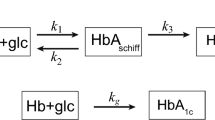Summary
Digoxin therapy has been made more rational by the measurement of serum digoxin concentrations. However, difficulties remain because of the overlap between “therapeutic” and “toxic” serum concentrations and the lack of an obvious therapeutic endpoint in many patients. An assay which measures the degree of interaction between digoxin and its putative receptor, the membrane Na+, K+-ATPase, might be capable of resolving some of these difficulties. Therefore, as a first approach in this direction we evaluated the relationship between serum digoxin concentration and the degree of inhibition of RBC ghost Na+, K+-ATPase activity in patients receiving digoxin therapy. Utilizing an improved micro-assay technique, Na+, K+-ATPase activity was determined in aliquots of RBC ghosts before and after removal of bound digoxin. In 27 patients a significant relationship was present between serum digoxin concentration and the degree of RBC ghost Na+,K+-ATPase inhibition. However, at any serum digoxin concentration, there was a variation in the magnitude of enzyme inhibition from patient to patient. This study confirms the feasibility of determining the degree of in vivo RBC Na+,K+-ATPase inhibition in man and demonstrates, for the first time, a highly significant but somewhat variable relationship between serum digoxin concentrations and the magnitude of RBC digoxin receptor inactivation. This quantitative, functional, individualized assay of digoxin effects may prove to be of clinical value in the future.
Similar content being viewed by others
References
Beller GA, Smith TW, Abelmann WA, Haber E, Hood WB (1971) Digitalis intoxication. A prospective clinical study with serum level correlations. N Engl J Med 284: 989–997
Ingelfinger JA, Goldman P (1976) The serum digitalis concentration-Does it diagnose digitalis toxicity? N Engl J Med 294: 867–870
Ford AR, Aronson JK, Grahame-Smith DG, Carver JG (1979) The acute changes seen in cardiac glycoside receptor sites,86Rb uptake and intracellular sodium concentrations in erythrocytes of patients during the early phases of digoxin therapy are not found during chronic therapy: Pharmacological and therapeutic implications for chronic digoxin therapy. Br J Clin Pharmacol 8: 135–142
Loes MW, Singh S, Lock JE, Mirkin BL (1978) Relation between plasma and red cell electrolyte concentrations and digoxin levels in children. N Engl J Med 299: 501–504
Akera T (1977) Membrane adenosinetriphosphatase: A digitalis receptor. Science 198: 569–574
Huang W, Askari A (1975) Red cell Na+,K+-ATPase: A method for estimating the extent of inhibition of an enzyme sample containing an unknown amount of bound cardiac glycoside. Life Sci 16: 1253–1261
Huang W, Forney RB, Patrick JR, Askari A (1977) Inhibition of red cell Na+,K+-ATPase in digitalized patients. Life Sci 20: 2037–2040
Seeman P, Weinstein J (1966) Erythrocyte membrane stabilization by tranquilizers and antihistamines. Biochem Pharmacol 15: 1737–1752
Kwant WO, Seeman P (1969) The membrane concentration of a local anesthetic (chlorpromazine). Biochim Biophys Acta 183: 530–543
Dodge JT, Mitchell C, Hanahan DJ (1963) The preparation and chemical characteristics of hemoglobin free ghosts of human erythrocytes. Arch Biochem 100: 119–130
Quarfoth GJ, Ahmed K, Foster D (1978) Effects of polyamines on partial reactions of membrane Na+,K+-ATPase. Biochim Biophys Acta 526: 580–590
Penney CL (1976) A simple micro-assay for inorganic phosphate. Anal Biochem 75: 201–210
Penney CL (1978) A simple micro-assay for inorganic phosphate II. Anal Biochem 89: 297–303
Lowry OH, Rosebrough NJ, Farr AL, Randall RJ (1951) Protein measurement with the Folin phenol reagent. J Biol Chem 193: 265–275
Yalow RS, Berson SA (1971) Introduction and general considerations. In: Odel WD, Daughaday WH (eds) Principals of competitive protein binding assays. JB Lippincot Company, Philadelphia, PA, pp 1–19
Snedecor GW, Cuchran WG (1976) Statistical methods. The Iowa State University Press, Ames, Iowa
Ku DD, Akera T, Brody TM, Weaver LC (1977) Effects of chronic digoxin treatment on canine myocardial Na+,K+-ATPase. Naunyn-Schmiedebergs Arch Pharmacol 301: 39
Mahler F, Karliner JS, O'Rourke RA (1974) Effects of chronic digoxin administration on left ventricular performance in the normal conscious dog. Circulation 50: 720–729
Griffiths BE, Penny WJ, Lewis MH, Henderson AH (1982) Maintenance of the inotropic effect of digoxin on long-term treatment. Br Med J 284: 1819–1822
Erdmann E, Krawietz W, Koch M (1974) Cardiac glycoside receptors in disease: The number of ouabain binding sites in human erythrocytes is subject to regulation. In: Skou JC, Nordby JG (eds) Na+,K+-ATPase structure and function. Academic Press, New York, pp 517–524
Cumberbatch M, Zareian K, Davison C, Morgan DB, Swaminathan R (1981) The early and late effects of digoxin treatment on the sodium transport, sodium content and Na+,K+-ATPase of erythrocytes. Br J Clin Pharmacol 11: 565–570
Ford AR, Aronson JK, Grahme-Smith DG, Rose JA (1979) The characteristics of the binding of 12-a-[3H]-digoxin to the membranes of intact human erythrocytes: Relevance to digoxin therapy. Br J Clin Pharmacol 8: 115–124
Akera T, Temma K, Wiest SA, Brody TM (1978) Reduction of equilibrium binding of cardiac glycosides and related compounds to Na+,K+-ATPase as a possible mechanism for the potassium induced reversal of their toxicity. Naunyn-Schmiedebergs Arch Pharmacol 304: 157–165
Aronson JK, Grahame-Smith DG (1977) Monitoring digoxin therapy: Determinants of the apparent volume of distribution. Br J Clin Pharmacol 4: 223–227
Erdman E, Hasse W (1975) Quantitative aspects of ouabain binding to human erythrocyte and cardiac membranes. J Physiol 251: 671–682
Zavecz JH, Dutta S (1977) The relationship between Na+,K+-ATPase inhibition and cardiac glycoside-induced arrythmia in dogs. Naunyn-Schmiedebergs Arch Pharmacol 297: 91–98
Author information
Authors and Affiliations
Rights and permissions
About this article
Cite this article
From, A.H.L., Quarfoth, G.J., Steele, B.W. et al. Erythrocyte Na+, K+-ATPase and serum digoxin concentrations. Eur J Clin Pharmacol 24, 807–812 (1983). https://doi.org/10.1007/BF00607092
Received:
Accepted:
Issue Date:
DOI: https://doi.org/10.1007/BF00607092




